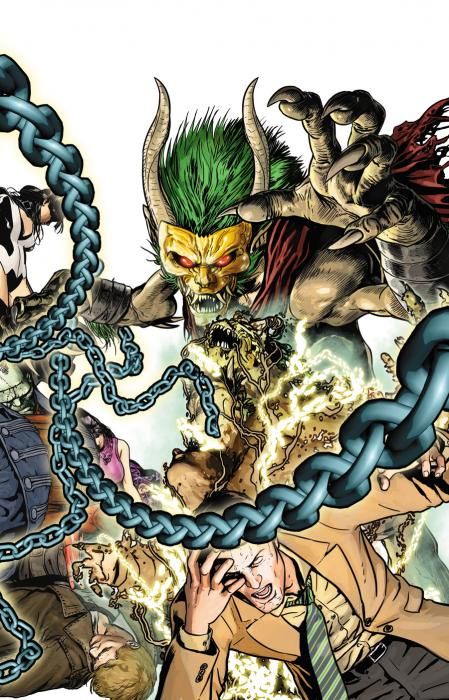"Justice League Dark #23.1: Creeper" with a story by Dan DiDio, writing by Ann Nocenti and nine pencilers, inkers and colorists is a book assembled by a veritable army. Unfortunately, the head does not know what the body is doing in this army, making the issue an incomprehensible mess.
Readers that have not been reading "Katana" will feel a bit at sea about which characters this title features, and the writing does nothing to ease that transition. Lots of narration boxes alternate between "the Creeper" (originally an Oni demon that only later takes that name) and what I can only guess is Katana's late husband and original owner of the Soul Taker Sword -- he's never actually identified beyond the Oni calling him "Mad Samurai." The narration, despite being incredibly heavy handed, doesn't bother to identify anyone in a timely fashion, and it's only through cobbling pieces of this book and other knowledge together that you can make sense of things -- sort of.
The story centers on the "mad Samurai" taking a bunch of souls, including the unnamed Oni demon that we will come to know as the Creeper, and going off the "Samurai path." While off path, the "mad Samurai" gets killed by his own sword, ends up inside it, trapped with all the other miserable souls, including the Creeper, who's made himself boss (or something). Being in the sword appears a fate worse than death, trapped and tortured, though it's also described as "mundane," so it's anyone's guess about what it's actually like inside the sword.
There are enough words here that visuals can be ignored entirely -- but that's not how a good comic should work. Then again, when you have nine artists on a book, it's probably pretty difficult as the writer to trust that visuals will deliver the story you intend. Collaboration and communication with that many cooks in the kitchen has got to be challenging. However, even the writing, spelled out as if it was prose, doesn't tell a good or clear story.
Bizarre scenes that emphasize the idea that there was no connection between writer and artists abound. In one scene, readers are treated to a stereotypical "biker bar" complete with dudes in leather vests with no shirts underneath, only to have the dialogue read (from said shirtless bar go-er) "Hey Dude. This is a nice joint. A family place. We're all here to relax. We don't want any trouble." A moment later, a "nice family of four" has their dinner disturbed by the fight and then two panels later characters escape into a parking lot where bikes and bikers lurk, ready to bust heads. None of it makes any sense in concept or execution.
The art, with so many hands on deck (including three pencilers, three inkers, and three colorists) is, in a word, tragic. The storytelling is painfully unclear, and frequently doesn't make a lick of sense even with the narration and dialogue plastered across it. Thanks to the book's army of artists, it's wildly inconsistent and there's no cohesion or any sense of direction. Perhaps most disturbing of all (beyond the incomprehensibility) is the missed opportunity to see inside the vaunted "Soul Taker Sword." This should have been an opportunity for the artist(s) to cut loose visually and really show us something. Instead, they present a weak impression of a Salvador Dali painting that doesn't look as terrifying as it looks odd and ill-defined. One can only assume from what is presented that nobody actually knows what it looks like in there -- even the creators.
This is perhaps the worst "big two" comic book I have ever read. A terrible idea coupled with rushed nonsensical visuals that never come together into a readable story. The fact that a book like this can make it past any kind of editorial process or quality control at DC Comics is a shock.

